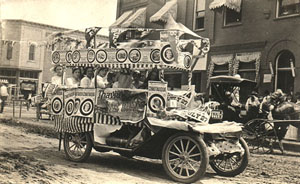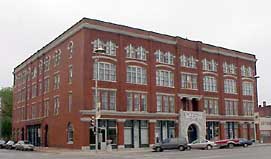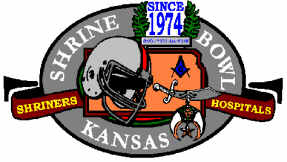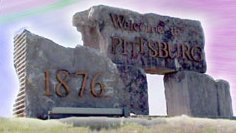About Pittsburg, Kansas


An Early-Day View of Pittsburg, Kansas
From National Archives, Special Collections
The Beginnings
Pittsburg is situated on US Highway 69 in the southeastern part of
Crawford County, Kansas, thirty miles from Joplin, Missouri.
It is reputed to be one of the most scenic cities in the country,
and it is the largest city in Crawford County.
In 1803, the southeast corner of Kansas was a part of the Louisiana
Purchase, and at this time, all land belonged to the Cherokee Nation.
In 1870, the company later known as the Frisco Railroad and a few
homesteaders obtained the land from the Cherokee and established a
settlement called "Hopefield." The settlement was located on the Old
Texas Road, an important wagon route and cattle trail from Fort
Leavenworth to Fort Gibson in Indian territory.
The 1870s saw the boom of coal and the influx of mine workers in
Southeast Kansas. It wasn't long before wagons were unable
to keep pace with the supply required by the increased business of the
zinc smelters in Joplin, and a faster, more direct route was demanded.
More than 90% of the coal mined in this area came from Pittsburg.
Franklin Playter, a banker and attorney, and a native of Ontario,
Canada, successfully negotiated a railroad to haul coal from the
Pittsburg area to the zinc smelters in Joplin. In 1876, Hopefield was
redesignated "Pittsburg," a name chosen by Playter after the vast
coal regions of Pennsylvania.
It was discovered that a Mitchell County post office already bore
the name Pittsburg, so the city was called "New Pittsburg" until
it was incorporated in 1880. M. M. Snow was elected first Mayor.
A general merchandise store opened by G. W. Seabury & Co. was the
the first business house in town. J. T. Roach erected the first
dwelling in July 1876. In its first year, the town's population
increased to about 100, and it contained three stores, two blacksmith
and wagon shops, a hotel, and post office.
The first school was taught in the town in the fall of 1877, with
A. J. Georgia as teacher. The school building was a two-story frame,
housing about forty students. A second school building was erected
in 1881. By 1885, the students numbered about 600.
Chautauqua


Chautauqua was founded in 1874 in New York, and and quickly spread
across the country. Circuit Chautauqua began in 1904 and by the
1910s could be found almost everywhere, presenting its message of
self and civic improvement to millions of Americans. At its peak
in the mid-1920s, Circuit Chautauquas appeared in more than 10,000
communities in 45 states.
Thousands came to see William Jennings Bryan, the most popular of
all Chautauqua attractions. Until his death in 1925 his populist,
temperance, evangelical, and crusading message could be heard on
Circuits across the country. Another popular reformer, Maud
Ballington Booth, the "Little Mother of the Prisons," could bring
her audiences to tears with her description of prison life and
her call to reform.
In the developing years of Pittsburg, Circuit Chautauquas
provided entertainment and education. Children and adults alike grew
more enthusiastic as the time neared for Chautauqua to arrive.
The Great Depression brought an end to most Circuits, although a
few continued until World War II. As a sort of wholesome and
morally respectable vaudeville, the Circuit Chautauqua was an
early form of mass culture.
Big Brutus

The newspapers called it a coal monster, and a monster it was.
Dubbed "Big Brutus," the enormous power shovel towered 16 stories
high and weighed 11 million pounds. When completed in June 1963,
Big Brutus, with its 90-cubic yard shovel, could move 150 tons
of coal in one bite, enough to fill three railroad cars. It was
the second-largest steam shovel in the world.
Big Brutus worked for only a decade because of environmental
problems and falling coal prices. By 1973, with operating costs as
much as $27,000 per month, the big shovel was obsolete. Deeming it
too big to move and too expensive to dismantle, its owners stripped
Brutus of its electrical and auxiliary equipment, leaving it to rust,
a dinosaur of the technological age.
Today, Brutus is one of the most unique day trips in Southeast
Kansas. Visitors can walk through its cavernous body, sit in the
operator's chair, or climb 16 stories to the top of the boom for
one of the best views anywhere of the rolling Kansas prairie.
Brutus is located 7 miles north of Columbus on K7, and 6 miles west
on K102.
Pittsburg Public Library

The Pittsburg Public Library, listed on the National Register of
Historical Landmarks, was built in 1910 by Andrew Carnegie. It is
the only Carnegie library not bearing his name on the exterior. Since
Carnegie was anti-union, Pittsburg unions protested the city's
accepting his donation. However, Carnegie yielded to the city's
wishes and built the library without his name. The Carnegie
building, dedicated in 1912, currently houses over 72,000 items.
In 1994, a special bond issue was passed to build a 14,000 square
foot addition and renovate the Carnegie building.
The Pittsburg Public Library is located at the corner of Fourth and
Walnut Street.
The Hotel Stilwell

The Hotel Stilwell in Pittsburg was built in 1887 and was the focal
point of the community. Several famous people stayed in its rooms
including Teddy Roosevelt, Carrie Nation, William Jennings Bryan,
and Clarence Darrow. The Scopes Monkey Trial was debated on the
balcony, and in the 1920s, the Kansas Governor moved his offices there
during a coal strike, conducting official state business within
its walls.
The hotel closed in the late 1970s and was saved from the wrecking ball
by group of local preservationists in 1994. The hotel again reopened
and is an integral part of the community. The Hotel Stilwell is
located at the corner of Seventh and Broadway.
Bison Herd and Mined Land Wildlife Area #1

Once, the plains were filled with magnificent bison. It's claimed that
the herds were so large one could not see the end of them. Wagon trains
could be delayed several days if they encountered a crossing herd.
At Bison Herd and Mined Land Wildlife Area #1, one can stop and view
a bison herd. The wildlife area is located three miles north of Pittsburg
on Highway 69.
Shrine Bowl

The annual Kansas East-West Shrine Bowl Football Classic is sponsored
by the five Shrine Temples in Kansas and involves our best high
school athletes, coaches, and cheer leaders.
Pittsburg and surrounding towns fully support the Shrine Bowl,
and Pittsburg is proud to have been host of the 2002 Shrine Bowl Game
and 2002 Band Camp, at Pittsburg State University.
Little Balkan Days

Little Balkan Days is the largest festival in Southeast Kansas.
Held on Labor Day weekend, it is a celebration of the community's coal
mining origins. Over 40,000 people arrive in Pittsburg to celebrate
mixtures of heritage and lifestyle.
Little Balkans Days is organized by the
Little Balkans Festival Association (LBFA), a non-profit
corporation of Pittsburg area residents.
Pittsburg State University

Pittsburg is home to Pittsburg State University (PSU), one of six higher learning
institutions in the Kansas Regents System.
The university was established in 1903 as the Auxiliary Manual
Training Normal School. It was later known as Pittsburg State Teachers
College.
The campus of the university is the site of many community special
events.


Contact Oceanus Hopkins Chapter DAR
Return to Home Page












![]()